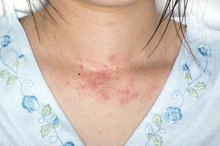Side Effects of Nystatin Medication
Nystatin is an antifungal medication that can be used to treat a variety of conditions 3. If applied to the skin as a topical cream it can combat fungal or yeast infections. It can also be taken orally to fight fungal infections in the mouth, intestines and vagina. Although generally safe for use, nystatin can cause some side effects 123.
If you are experiencing serious medical symptoms, seek emergency treatment immediately.
Formulations
Nystatin can come in the form of ointments or creams, which can be applied topically to treat fungal infections of the skin 3. For patients with an oral fungal infection, the nystatin typically comes as a liquid, which is swished around in the mouth and then expelled via spitting 3. Nystatin can also be taken as a tablet or oral suspension to treat internal fungal infections 3.
Gastrointestinal
Nystatin Side Effects for Infants
Learn More
When nystatin is taken orally for infections of the vagina, mouth or intestines, it can cause localized irritation of the gastrointestinal tract 3. If the intestines become inflamed, diarrhea may result, Drugs.com reports. Bloody diarrhea occurs only in very rare instances, RxList notes. Other reported side effects include upset stomach, stomach irritation, nausea and vomiting.
- When nystatin is taken orally for infections of the vagina, mouth or intestines, it can cause localized irritation of the gastrointestinal tract 3.
Stevens-Johnson Syndrome
Stevens-Johnson syndrome is a potentially life-threatening skin reaction that occurs extremely infrequently with the use of nystatin 3. In Stevens-Johnson syndrome, also known as erythema multiforme, patients initially develop flulike symptoms that are then followed by a purple or red skin rash that can cover a large area of the body. The rash eventually blisters, and the top layer of the skin dies and is shed by the body. This condition is very dangerous because it results in massive skin loss, exposing large tracts of immature or underdeveloped skin to the surface. This can result in serious pain and infections. Stevens-Johnson syndrome is a medical emergency, so patients who develop a rapidly spreading rash should immediately contact a medical professional.
- Stevens-Johnson syndrome is a potentially life-threatening skin reaction that occurs extremely infrequently with the use of nystatin 3.
- In Stevens-Johnson syndrome, also known as erythema multiforme, patients initially develop flulike symptoms that are then followed by a purple or red skin rash that can cover a large area of the body.
Allergies
Betaderm Side Effects
Learn More
Another potential side effect of using nystatin is an allergic reaction 23. Patients who are allergic to nystatin may have a variety of symptoms, depending on the severity of the allergy 3. The mildest allergic symptoms are a rash, which can occur where nystatin is applied to the skin, or anywhere on the body if the medication is taken orally 3. More severe allergic reactions result in swelling, which may occur in the tongue, lips, face or in the extremities, such as the fingers. Anaphylaxis, the most dangerous type of allergic reaction, causes the throat to swell; this may result in difficulty swallowing or breathing and can also cause chest tightness and hoarseness. Patients who are allergic to nystatin should not use the medication due to the risk of anaphylaxis 3.
Skin
When nystatin is applied to the skin, it can result in localized irritation or inflammation, usually with a burning or itching sensation in the treated area, EMedTV explains 23. Patients can also develop a rash or eczema on the treated area. Pain when applying the product has also been reported.
- When nystatin is applied to the skin, it can result in localized irritation or inflammation, usually with a burning or itching sensation in the treated area, EMedTV explains 2.
- Patients can also develop a rash or eczema on the treated area.
Considerations
Patients should not use nystatin for more than two weeks at a time; if it hasn't worked by then, the symptoms may not be caused by a fungal infection, and taking it this long can increase the risk of side effects 123. Patients utilizing a liquid form of nystatin for the treatment of oral fungal infections should not swallow the medication, as it is not designed to be ingested 3. Contact your health care provider if your side effects become unbearable or if your condition does not go away after 14 consecutive days of treatment.
Related Articles
References
Writer Bio
Adam Cloe has been published in various scientific journals, including the "Journal of Biochemistry." He is currently a pathology resident at the University of Chicago. Cloe holds a Bachelor of Arts in biochemistry from Boston University, a M.D. from the University of Chicago and a Ph.D. in pathology from the University of Chicago.








